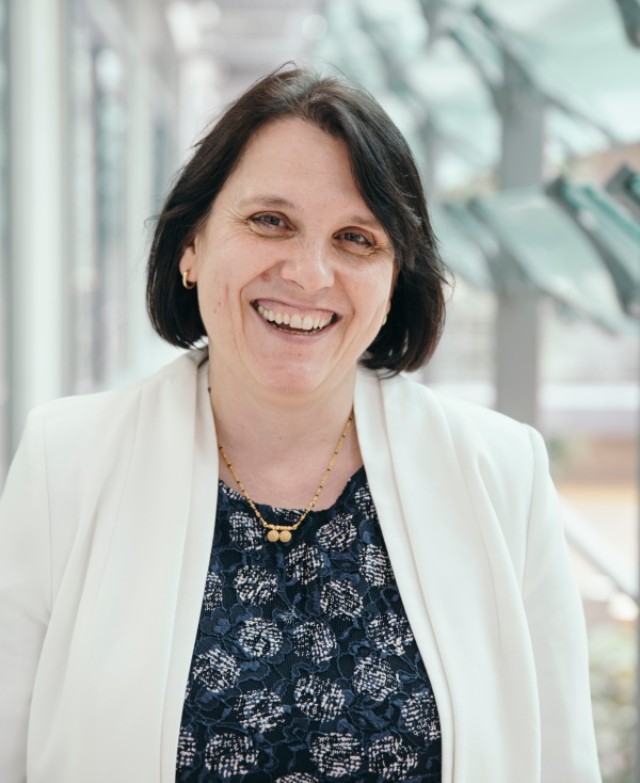16 June 2020
from 14:30
to 16:30
Online Colloquium | Claudia Felser - Director at the Max Planck Institute for Chemical Physics of Solids in Dresden, Germany
Address / Location
The Colloquium will take place online on Zoom.
The Zoom link will be send via Email through the lists below.
The MCQST Colloquium Series features interdisciplinary talks given by visiting international speakers. The monthly colloquial covers topics spanning all MCQST research units and are available to audiences worldwide. The main goal of the series is to create the framework for idea exchange, to strengthen links with QST leading groups worldwide, as well as to act as an integral part of the local educational environment.
 © MPG
© MPG Topological materials science
Topology, a mathematical concept, recently became a hot and truly transdisciplinary topic in condensed matter physics, solid state chemistry and materials science. Since there is a direct connection between real space: atoms, valence electrons, bonds and orbitals, and reciprocal space: bands, Fermi surfaces and Berry curvature, a simple classification of topological materials in a single particle picture should be possible [1].
Binary phosphides are an ideal material class for a systematic study of Dirac, Weyl and new Fermion physics, since these compounds can be grown as high-quality single crystals. A new class of topological phases that have Weyl points was also predicted in the family that includes NbP, NbAs. TaP, MoP and WP2. [3-5]. Beyond Weyl and Dirac, new fermions can be identified in compounds that have linear and quadratic 3-, 6- and 8- band crossings that are stabilized by space group symmetries [2]. Crystals of chiral topological materials CoSi, AlPt and RhSi were investigated by angle resolved photoemission and show giant unusual helicoid Fermi arcs with topological charges of ±2 [6,7]. In agreement with the chiral crystal structure two different chiral surface states are observed. In magnetic materials the Berry curvature and the classical anomalous Hall (AHE) and spin Hall effect (SHE) helps to identify potentially interesting candidates. As a consequence, the magnetic Heusler compounds have already been identified as Weyl semimetals: for example, Co2YZ [8-11], and Co3Sn2S2 [12-15]. The Anomalous Hall angle also helps to identify materials in which a QAHE should be possible in thin films. Heusler compounds with non-collinear magnetic structures also possess real-space topological states in the form of magnetic antiskyrmions, which have not yet been observed in other materials [16].
[1] Bradlyn et al., Nature 547 298, (2017), Vergniory, et al., Nature 566 480 (2019),
[2] Bradlyn, et al., Science 353, aaf5037A (2016).
[3] Shekhar, et al., Nat. Phys. 11, 645 (2015)
[4] Liu, et al., Nat. Mat. 15, 27 (2016)
[5] Gooth et al., Nature 547, 324 (2017)
[6] Schröter, et al., Nature Physics 15, 759 (2019) preprint arXiv: 1812.03310
[7] Sanchez, et al., Nature 567, 500 (2019)
[8] Kübler and Felser, EPL 114, 47005 (2016)
[9] Wang, et al. Phys. Rev. Lett. 117, 236401 (2016)
[10] Chang et al., Scientific Reports 6, 38839 (2016)
[11] Belopolski, et al., Science 365, 1278 (2019)
[12] Liu, et al. Nature Physics 14, 1125 (2018)
[13] Liu, et al. Nat. Phys. Nature Physics 14, 1125 (2018)
[14] Liu, et al., Science 365, 1282 (2019)
[15] Morali, et al., Science 365, 1286 (2019)
[16] Nayak, et al., Nature 548, 561 (2017)
Online talk
The Zoom link for to access the talk will be distributed via the mailing lists: [mqc-info], [wiss-mpq] and [Mpq-colloquium-stream]. If you already receive mails from [wiss-mpq], there is no need to register to [Mpq-colloquium-stream]. Make sure to subscribe to one of the lists in order to receive the link.
You can register here for the mailing lists: